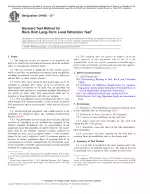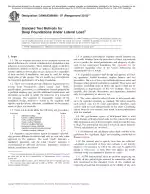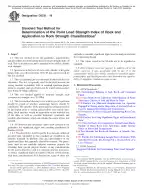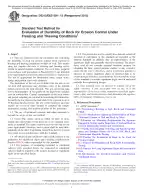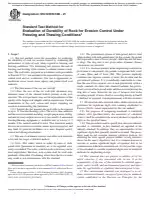ASTM D4436-13e1 PDF Download
Standard ENStandard Test Method for Rock Bolt Long-Term Load Retention Test
Also Known As:
ASTM D4436-13e1 is a standard test method that aims to determine the long-term load retention of rock bolts. Rock bolts are commonly used for support in various mining and civil engineering applications. Over time, the load on a rock bolt tends to decrease due to factors such as borehole wall deterioration and creep. To prevent this decrease in load, the bolt can be encapsulated by filling the bolt hole with cement grout or synthetic resins. The rate at which the load decreases determines the interval at which the bolt needs to be encapsulated during construction.
The characteristics of the rock, such as the roughness of the borehole and induced fractures, play a significant role in the load loss of the bolt. Therefore, realistic values can be obtained by drilling test holes using the same methods as those used for the construction boreholes.
In establishing a testing program, several factors need to be considered. Load retention tests should be conducted in all rock types where construction bolts will be installed. If the rock is anisotropic (e.g., bedded or schistose), the tests should be conducted in the same orientations relative to the anisotropy as the construction bolts will be installed. Sufficient tests should be conducted in each rock type, orientation, and anchor system to determine the average and minimum long-term capacities within a fixed uncertainty band at the 95% confidence level. The number of tests required depends on factors such as rock quality, expected project lifetime, and the importance of the areas to be bolted. It is recommended to conduct at least six long-term tests for a single set of variables to meet statistical requirements.
The design load and installation load on the rock bolt system should be predetermined. The installation load is less than the anchor capacity, which is determined by another test method, Test Method D4435. The design load is less than the installation load, and the amount depends on rock properties and the minimum time required to encapsulate the bolts. Alternatively, the test can be run for a predetermined time interval based on construction requirements, and a realistic design load can be determined from the data.
It is important to note that the competence of personnel, as well as the suitability of equipment and facilities, can affect the quality of the results obtained from this standard. Compliance with Practice D3740, which evaluates these factors, does not guarantee reliable results.
| Descriptors | rock bolts, rock bolt long-term load retention test,Anchors,BoltsCOMMA Screws and Studs,Pull-Out Test,Tensile Test |
| ICS Codes | 93.020 - Earthworks. Excavations. Foundation construction. Underground works |
| Language(s) | English |
| File Size | 112.6 KB |

